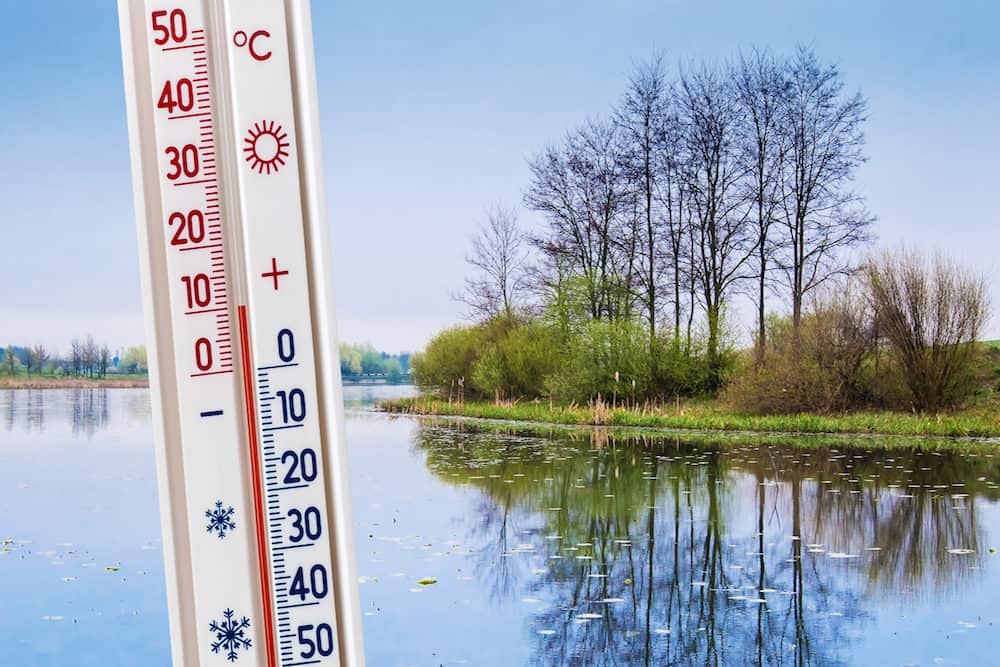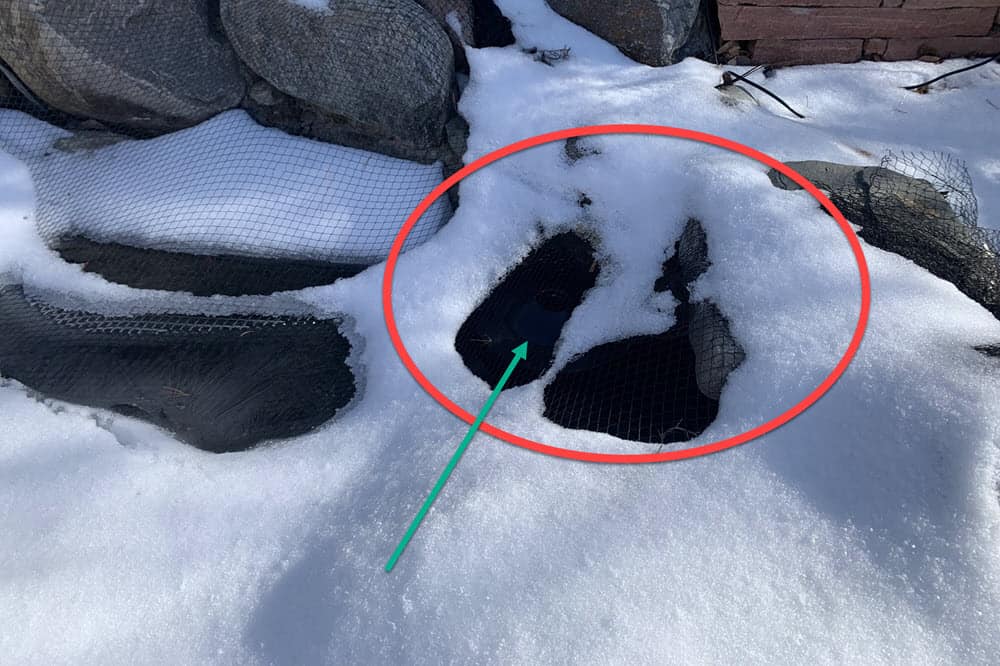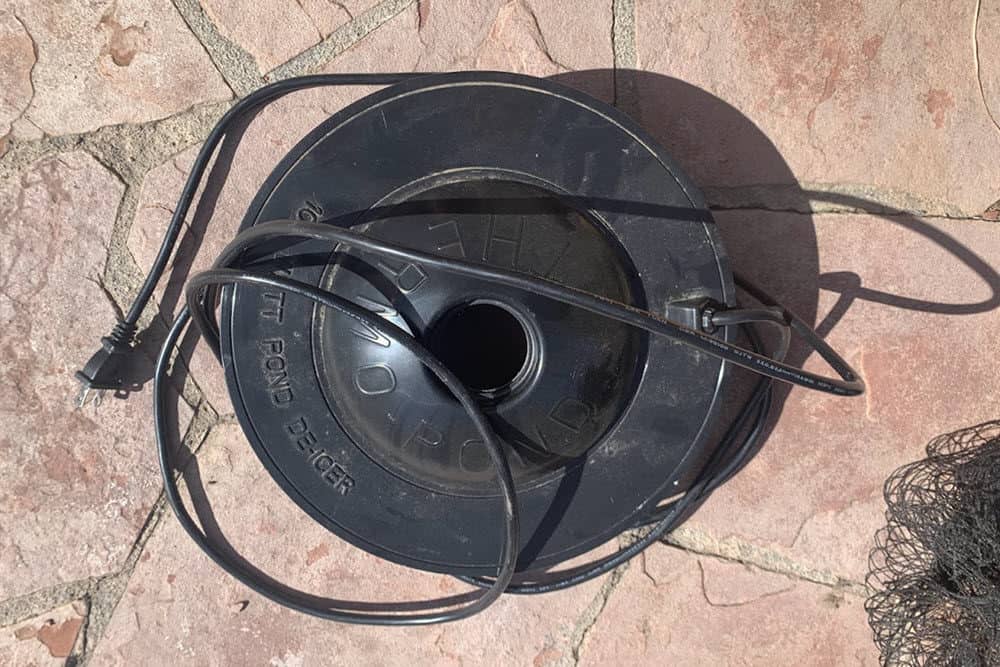Heaters are essential to any koi pond if you live in a more climate zone where temperatures can dip below freezing for long periods of time. In the US, this encompasses most of the country except for some of the coastal regions and the deep south. The winter weather can freeze your pond and shock koi fish that are originally from warmer climates. Heating your pond is a way to allow your koi fish to adjust to their new habitat without getting stressed or becoming sick due to the temperature.

Koi pond heaters were originally only used by fish breeders or farmers to maintain a certain water temperature for large amounts of fish. However, heaters and koi pond deicers have become more popular as technology improved and costs went down. Now, many people use an outdoor fish pond heater to create a comfortable pond temperature and environment for their koi fish during the cold winter months.
As a hobbyist and pond owner, I don't have the same expertise as koi shop owners. However, moving into a new house with a koi pond led me to research all that I could about maintaining koi ponds and healthy fish. As I continue researching and learning, I want to share my knowledge with those who need a quick answer to common questions about their koi ponds in one place.
In this article, we'll look at what a bead filter is and how it works. It's also important to know where it is located and how to manage and maintain it to ensure it keeps your koi pond clean for a long time.
Here is a quick breakdown of what we'll be talking about in this article:
Note, if you need help maintaining your pond, check out our koi pond maintenance service directory to find someone local who can help.
A water heater is designed to control the temperature of your pond. It allows your koi fish to swim comfortably in a stable environment all year round, which allows them to feed regularly and even avoid hibernating in the winter. There are three common types of koi pond water heaters: gas-fired boiler, electric heater, and koi pond deicer.
With a gas-fired boiler, water heats inside the boiler and then moves into the heat exchanger while pond water pumps into a different chamber to absorb the heat from the other chamber. Water constantly circulates in this type of water heater, but it can be somewhat expensive to maintain all year.
The inline electric water heater raises the temperature of water over time by warming it via an electrical heating element. This element inside the unit heats the water as it passes through and returns it to the pond. As water continuously pumps through this heater, the koi pond eventually reaches the set temperature.
Deicers are the most common water heater for koi ponds. It typically floats on top of the pond, acting as a localized floating pond heater that creates holes in the ice to allow lots of oxygen to flow. It allows your fish, and beneficial bacteria to breathe even during hibernation. Deicers do not heat your entire pond, but they ensure no harmful gas builds up in the water and your koi fish can breathe properly.

Heaters are typically for outdoor koi fish ponds during the cold winter months. It reduces the shock for koi when they are placed in a new environment. It also allows you to maintain a stable pond ecosystem outdoors, feed them all year, and improve their patterns and colors.
Cold water causes koi fish to hibernate, and they lose weight and become more susceptible to parasites and illnesses. Keeping the koi pond heated will also allow nitrifying bacteria to thrive and keep the water clean year-round.
All of these factors can affect a koi's immune system if it is not in the right balance. Even for hobbyists, having a water heater can certainly improve and maintain the overall health of your koi fish.
If you are looking for an outdoor pond heater for koi, there are a few features to look for before you buy. The size and efficiency are crucial because you want to make sure the heat output can match the cold weather. Take a look at some of the other factors to consider when looking at koi pond heaters for sale.
The size of your koi pond heater for the winter depends on how cold the weather can get, how often you plan to heat it, and how large your pond volume is.
The heater model will tell the maximum number of gallons it can heat. Generally, every 1 kilowatt (kW) of power heats 1,000 gallons. If you have a 6,000-gallon pond, then you would want a heater with a maximum power of 6kW.
A heat pump is also more efficient than oil, gas, or electrical heating. Heat pumps should output more heat than input in colder weather. Heat pumps are also the cheapest type of heater for koi ponds due to their high efficiency.
Most heaters have both cooling and heating capabilities to keep a stable water temperature year-round. This allows the pond to remain at the same temperature, warming it when the water gets cold and cooling it when the water exceeds the desired temperature. That way koi fish don't experience the shock of fluctuating water temperatures during the fall and spring as the weather changes.
To save energy and reduce costs, use a cover on your pond during the winter. Building insulation into the pond floor and walls will also minimize heat loss and running costs as well.
If you are looking to save costs as a hobbyist and your pond fish are already used to cool water, you can use a deicer instead during the winter to provide oxygenation in your pond. Smaller ponds also trap heat better than larger ones, so you may only need a deicer to remove the top ice from the water.

Koi fish are cold-blooded and can handle low temperatures just fine as long as they have enough oxygen to breathe. However, when the temperature drops and the water temperature fluctuates, it affects the pond's ecosystem and makes your koi more vulnerable. There are a few ways you can prepare your koi fish pond for the winter and colder weather.
The first thing to do is cover your pond and install a heater, or move your koi into a temporary tank indoors for the winter if you want to avoid heating costs.
Another way to keep your koi pond covered in the winter is by building a greenhouse over it. It can be as simple as attaching a plastic sheet to some PVC pipes and enclosing the pond underneath by holding it down with heavy objects. Then you don't need to worry about heat loss as you run the water heater for koi pond.
At around 65-68 degrees Fahrenheit, your koi fish's eating habits begin to change. When water gets colder, koi eat less. When it is warmer, koi fish eat more, create more waste, and have better immune systems as a result. During fall and spring when the weather changes, it is important to keep an eye on the water temperature and feed your koi fish accordingly.
Here are the various times to feed them according to the water temperature, not the outside temperature:
When the water temp dips below 50 degrees, it is time to cut off the fish food as koi can't properly digest at very cold temperatures.
If you keep your koi in an outdoor pond during the winter, you'll still run the pond pump (or pond aerator) and use your pond filtration system, just make sure that your pump and all filters don't freeze over. You'll want to make sure they are kept deep enough in the pond - below the level where ice can form.
If you have a very small pond that isn't very deep, you may need to bring your koi indoors for the winter.
Whether or not you decide to use a pond heater, deicers are an essential investment to keep oxygen flowing into your pond. If the pond is covered with ice without an opening, the fish would not receive enough oxygen and eventually suffocate.
Seasonal Defense Can Be Used in Your Pond to Maintain Pond Health During Winter Months
You may wish to add a winter water treatment to help break down any organic matter in the pond to prevent excess sediment in your pond. Seasonal Defense is one product that you may wish to consider adding to your pond.
In extremely cold temperatures below freezing, you may want to prepare a backup source of extra heat for your koi pond. It can also act as a backup if your heat pump fails. Some heat pumps may also require a minimum temperature to start heating your pond, so a secondary heat source can warm the water enough to meet the minimum temperature to allow the pump to work on its own.
In case you find your pond lacks oxygen as well, you can use an aerator any time of the year. If fish are hibernating in the cold water, there will be more oxygen available as long as the air can circulate. However, if you are heating your pond and have it covered, oxygen may become more in demand as your koi fish stay active. An aerator can easily increase the oxygen levels in the water to make the environment and ecosystem thrive no matter the season.



